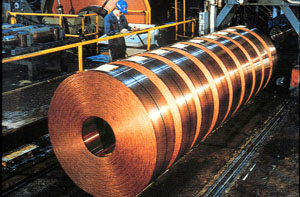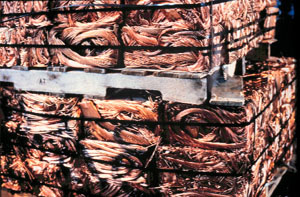Green Roofs for a Greener Environment
Copper Applications in Health & Environment
Something old is new again...
Copper roofs are certainly not a new idea; they've been around for years. In fact, a lot of copper roofs are very old, and some are very, very, very old. In Europe, it's easy to find cathedrals and other buildings whose copper roofs were originally installed hundreds of years ago.
Copper has long been used for temples and shrines in Japan, as well. Among other benefits, copper doesn't crack when a Japanese building is rattled by one of the country's frequent earthquakes. Copper roofs have also been used for many years in North America. Canada's stately Houses of Parliament are just one well-known example. The U.S. has historically been a steady but modest market for copper roofing. Until fairly recently, we've used copper mainly for churches, synagogues and other public buildings. But that's changing rapidly.
In the past few years, copper roofing has been undergoing a spectacular boom in popularity. Consumption of copper for roofing has risen an average of 8% per year since 1992 - more than twice the rate of new housing starts. From 1996 to 1997, it jumped more than 14%, and it looks like the accelerating trend will continue, at least for awhile. In addition to traditional uses in public buildings, copper is now gaining wide acceptance in small office structures, shopping malls, sports arenas and even private homes.
Why is this centuries-old product - copper roofing -suddenly becoming so popular? Two important reasons are the public's increasing demand for quality and American architects' growing awareness of copper's unique characteristics. Another factor is the easier installation made possible by new on-site construction methods. And, of course, there's the fact that people like copper roofs because they simply look good.
 Copper Strip
Copper StripBut with consumption rising by the millions of pounds each year, should we be concerned that there won't be enough copper available to satisfy the market? Will growing demand lead to scarcity and send the price through the roof, as it were?
The answer to both questions is a very definite no, and the explanation is simple: copper roofing sheet is predominantly made from copper scrap.
Copper is one of the most thoroughly recycled among what we might call structural metals. Most people don't realize it, but nearly one-half of the copper used in the U.S. today has been used before. Worldwide numbers are about the same.
 Copper Scrap
Copper ScrapOne reason for copper's high recyclability is that it's so durable. Unlike other metals, copper corrodes exceedingly slowly in natural environments. That's why those European cathedrals and Japanese temples still have their original roofs. The copper roofs react a bit with the atmosphere during the first few years after installation to produce the familiar gray-green patina, like that on the Statue of Liberty. After the protective patina forms, corrosion drops to little more than a few millionths of an inch per year.
The point is that copper lasts a long time, and most of what has been used before is still around, being used again in another form.
Recycling Copper: A Win-Win Situation
Here's how the process works: Copper that is no longer useable, such as old wiring and plumbing tube from demolished or renovated buildings, is collected by companies that make up the very efficient recycling industry. We used to call them scrap dealers, but they're really a key part of the nation's recycling system. They sort the old copper, bundle it and otherwise prepare it for market.
Refineries buy the recycled metal and convert it back to pure copper. Such so-called "re-refined" copper represents a tremendous energy saving since the huge amount of work ordinarily needed to mine, crush and smelt ore doesn't have to be done again. As an important added benefit, re-refined copper's lower energy needs mean less fuel consumption and fewer emissions of unwanted gases to the atmosphere. No question, recycling copper is a win-win situation.
A lot of recycled copper scrap is bought directly by mills that produce roofing sheet. There are three primary producers of roofing sheet in the U.S.: Hussey Copper Ltd. Leetsdale, PA; Outokumpu American Brass Company, Buffalo, NY, and Revere Copper Products, Inc., Rome, NY. All rely heavily on scrap copper as one of their raw materials.
Some of these companies have the capability to re-refine scrap copper to the extent needed to make new roofing sheet. Others simply remelt scrap of sufficiently high quality and blend it with new copper, thereby diluting the concentration of impurities to the point where the copper will be ductile enough to be rolled into sheet. All mills also recycle the so-called "runaround" scrap generated in their own plants. Nothing as valuable as copper ever goes to waste.
Whether re-refined or simply remelted, the mills cast the copper in huge 22,000-pound ingots called "cake", which are then conditioned and rolled into thin sheets. The sheet copper is sold through metal distribution centers or directly to large users. The metal may be pre-patinated by the mill so that it can be sold with the pleasing (and protective) gray-green color already in place. Pre-patination is becoming increasingly popular since it allows the architect and builder to produce a building in its "final" form without having to wait for nature to take its course.
Some roofing sheet is sold to companies that fabricate roofing shingles, which are installed and used just like ordinary shingles, except that they look much better and last far longer. Roofing shingles, which are already popular in Japan and other countries, have a bright future in the U.S. homeowner market.
Scrap Recycling is Important
How much scrap is used to make roofing sheet? It varies, depending on market conditions (including the availability and price of both scrap and new copper) and the melting and refining processes used by the various producers. Because of these factors, scrap use can range between 50% and 100% of consumption for any of the producers at any given time, but an industry-wide average over time is probably close to 60%.
That's a lot of copper, and it represents enormous energy savings. More important, it's metal that will never be discarded or end up in a landfill. Maybe it is fitting that the color of a copper roof's patina is pleasantly green. In a way, the color reflects the environmentally friendly recycled metal that went into making it.
Also in this Issue:
- Trapping Sulphur
- Green Roofs for a Greener Environment
- Overview of Recycled Copper
